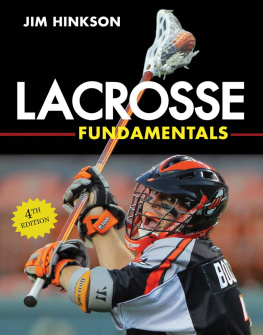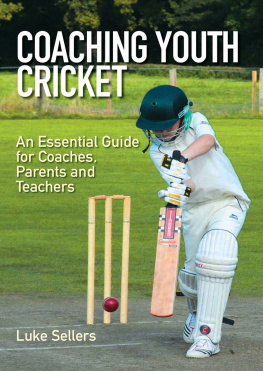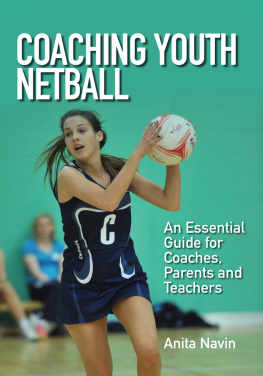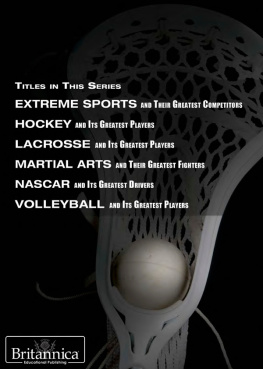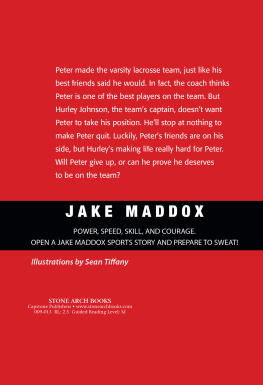Copyright 1993, 2000, 2006, 2012 by Jim Hinkson
No part of this publication may be reproduced, stored in a retrieval system, or transmitted in any form by any means, electronic, mechanical, photocopying, or otherwise, without the prior written permission of the publisher, Triumph Books LLC, 542 South Dearborn Street, Suite 750, Chicago, Illinois 60605.
Library of Congress Cataloging-in-Publication Data
Hinkson, Jim.
Lacrosse fundamentals / Jim Hinkson.
p. cm.
ISBN 978-1-60078-693-8 (pbk.)
1. Lacrosse. I. Title.
GV989.H563 2012
796.347dc23
2011052141
This book is available in quantity at special discounts for your group or organization. For further information, contact:
Triumph Books LLC
542 South Dearborn Street
Suite 750
Chicago, Illinois 60605
(312) 939-3330 Fax
(312)663-3557
www.triumphbooks.com
Printed in the U.S.A.
ISBN: 978-1-60078-693-8
Design by Patricia Frey
Photos courtesy of John Smith
This book is dedicated to my wife, Cynndy, for her great support, and to my family whom Im so proud of: Maggie and Jeff Webb, Kate Hinkson and Chris St. John, James Hinkson and Sarah Digby, and my two granddaughters, Sophie Webb and Elyse Webb
Contents
Key to Diagrams
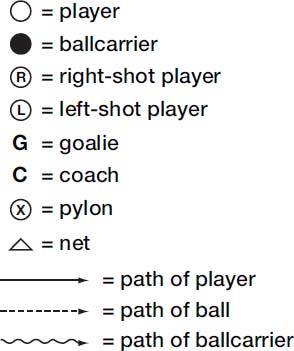
Foreword
Lacrosse is more than a game among members of my family and among the families of the Longhouse on the Territory of the Onondaga Nation.
I remember the first time that my father and I played catch. I was about five years old when he asked me to come out with him. He handed me a lacrosse stick and a ball. He showed me how to throw the ball. We played catch. That day, although it was more than 55 years ago, is still in my mind as if it were yesterday. I received my first stick when I was about 10 years old. It was made of white ash and was the stick that I used until it broke during a game when I was 17 years old. I played league lacrosse until I was 41.
During these years I learned what the game really meant. I watched my father as he prepared to leave for games in arenas in Syracuse, Geneva, and Rochester, New York. He played professional box lacrosse during the 30s. He also played field lacrosse against colleges in our area. His team was good enough to try out for the 1932 Olympics in California. My grandfather played field lacrosse until he was 60 years old. My three sons have also played box and field lacrosse. Each has had a stick in his hands since he was two years old. One is presently playing for a college and one played pro box with the Buffalo Bandits. All three have played high-school lacrosse and all three play for the Iroquois Nationals, a team composed of members of the Haudenosaunee (Iroquois Confederacy). Someone from my family has been on the lacrosse field for the past 100 years.
As my boys grew up I taught them the same respect for the game that my father had taught me. The game was given to us by the Creator for his enjoyment. We believe that when there is a game being played here on earth there is a game being played in the land of the Creator at the same time. The game is for the spiritual and physical peace of mind of our people and gives us a chance to display our gifts for the Creator: the gifts of being able to run, catch, and throw; of being able to think and make split-second decisions; and most importantly, it gives us the opportunity to work together as a unit. Lacrosse is a very intrinsic component of our heritage and spiritual culture. When I play lacrosse it makes me feel like I am playing the game with all of my ancestors. It also makes me proud that it was our people who gave lacrosse to the world. For these reasons, lacrosse is more than just a game.
Dawnaytoh,
Chief Irving Powless
Onondaga Nation
Preface
This book is an accumulation of my ideas from 34 years of playing, coaching, and instructing for the Ontario Lacrosse Association.
I was introduced to lacrosse in 1962 by Hall of Famer Jim Bishop, who knew only one way to play the game: Fast-Break. From these special roots Ive grown and added my own ideas, as well as other coaches ideas that Ive borrowed, stolen, and imitated about how to play the game.
Lacrosse may be called by different namesbox lacrosse, indoor lacrosse, inter-lacrosse, and field lacrosseand it may be played in different environments with different rules. But the bottom line is that in all these different forms, a player still has to pass and catch, beat a defender, and shoot at a net, with only a lacrosse stick and a ball.
Lacrosse is a very simple game. Its object: to put the ball into the net. It is a game of tempo and rhythm, with two teams running up and down the floor; yet, like all sports, it is a game made up of fundamentals. Its through repetitive practice of these fundamental skills that teams are successful. There is an old saying: Its not what you do, but how you do it. In lacrosse this translates to: the type of system a team plays is not as important as how well a team executes the fundamental skills within that system.
The execution of these fundamentals is presented in this book: how to beat a defender one-on-one, how to throw a perfect pass to a teammate, how to catch a ball in traffic, how to score on a goalie, and many other skills.
Ive tried to describe the fundamentals as clearly and simply as possible. Ive tried to break the skills into a checklist of key points. Remember, these fundamentals are not just any fundamentals thrown together, but ones that complement the Fast-Break system. So, as you read, keep in mind that Im giving you one proven method. Take from the book ideas that you can use and feel good about that reinforce what you are doing already.
Ive also presented some basic strategies and tips on how players should think and act in certain situations. At the end of each chapter are drills presented in simple step-by-step progressions from the easiest to the most difficult. Practicing these drills will refine a players skills.
By breaking the game into basic skills, the player, coach, and fan can analyze and thereby better understand and appreciate this great sport.
Finally, a special note to the parents: this book is written not only for the player, coach, and educator, but also for you. Its a tool for parents who want to work with their sons and daughters on their own time. Even if you cant handle a lacrosse stick, take this book and the ideas presented in it, grab a baseball glove, and practice passing and catching with your child. Having a stick yourself isnt essential. Understanding skills and techniques of the game is.
Jim Hinkson, 2011
Whitby, Ontario, Canada
Introduction
Like most Canadian youngsters, I played lacrosse and hockey. The speed, the keen competition, the sheer exuberance of these sports allowed for the development of athleticism in a young boy. As I grew older, I began to recognize the tactics and strategies of these games; I became a student of sports. Later, as a teacher and coach, I tried to channel those spirits in my students, to impart to them the elementary rules, to instill in them the love of the game and respect for the opponent. Teaching fundamentals, increasing knowledge without destroying or limiting ones enthusiasm for a subject, is sometimes difficult for a teacher and a coach to accomplish.
In a sport like lacrosse there is a continuous movement, a flow that exhilarates the player and arouses the spectator. It is difficult to take that energy and slow it down to examine its creation. A step-by-step re-creation of the fundamentals is neededlike watching a film in slow motion to capture the subtleties of each players abilities. We watch every move; we observe the hand-to-eye coordination so needed to succeed in this sport. Jim Hinkson has known the ebb and flow of such play and has put it into words, using instructional photographs and diagrams to complement them.
Next page
